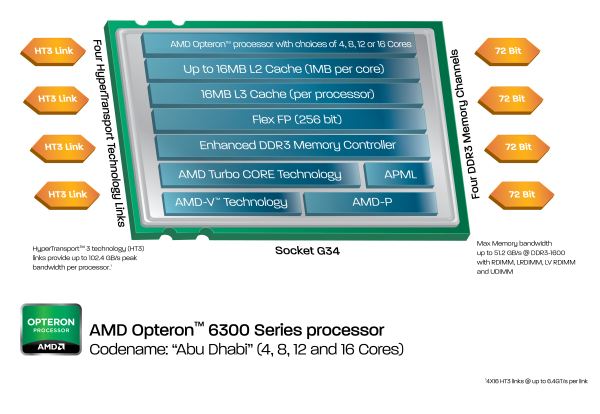The new Opteron 6300: Finally Tested!
by Johan De Gelas on February 20, 2013 12:03 AM ESTAMD unveiled their Opteron 6300 series server processors, code name Abu Dhabi, back in November 2012. At that time, no review samples were available. The numbers that AMD presented were somewhat confusing, as the best numbers were produced running the hard to assess SPECJbb2005 benchmark; the SPEC CPU2006 benchmarks were rather underwhelming.
Compared to an Opteron 6278 at 2.4GHz, the Opteron 6380 (2.5GHz) performed 24% better, performance per Watt improved by 40% according to AMD. In contrast, SPECint_Rate2006 improved by only 8%, and SPECfp_Rate2006 by 7%. However, it is important to note that SPECCPU2006 rates do not scale well with clockspeed. For example an 8% clockspeed (6380 vs 6376) only results in a 3.5% higher SPECint_Rate2006 and a 3% higher SPECfp_Rate2006. And the SPEC CPU 2006 benchmarks were showing the Interlagos Opteron at its best anyway. You can read our analysis here.
Both benchmarks have only a distant link to real server workloads, and we could conclude only two things. Firstly, performance per GHz has improved and power consumption has gone down. Secondly, we are only sure that this is the case with well optimized, even completely recompiled code. The compiler setting of SPEC CPU 2006, the JVM settings of Specjbb: it is all code that does not exist on servers which are running real applications.
So is the new Opteron "Abu Dhabi" a few percent faster or is it tangibly faster when running real world code? And are the power consumption gains marginal at best or measureable? Well, most of our benchmarks are real world, so we will find out over the next several pages as we offer our full review of the Opteron 6300.











55 Comments
View All Comments
JohanAnandtech - Wednesday, February 20, 2013 - link
Per Core. So with the -np 32 setting. I have tried less before, but the LS-DYNA really likes the extra load and store units of the second unit. so 32 MPI processes give a 30% boost.alpha754293 - Wednesday, February 20, 2013 - link
That's a healthy boost! It's amazing how these technologies are maturing to the point where conventional wisdom that they might be starved for FPU resources isn't enough to slow them down.It'd be interesting to see whether it makes a difference if you were to let the OS handle the job/process scheduling or whether manual intervention can help reduce some of the thread/process migration overhead, especially across 16 FPUs.
dmytty - Friday, February 22, 2013 - link
Before the benchmarks came in, I looked at an HPC build for the new 6300 series. I saw the real sweet spot for AMD being the 6344 which is a CPU of type 2.6 Ghz @ 12 or 6 core (depending how you define a 'core'). Anandtech never mentioned this CPU in the review. (?)In simple $ terms for the CPU, it's the E5 2640 @ $815 vs the Opteron 6344 @ $415. So how does AMD not have a decisive price advantage?
In 4S land the price advantage widens.
AMD 4S...I priced a build (not including a case) at ~$3860 for 4 x 6344, 128 GB RAM, mobo and PSU. Note that this mobo could also go out to 256 GB. CPU cost is 4 x 6344 = $1660. Again, total system cost was $3860.
Intel 4S...I picked the 4607 as being the best 'bang for the buck processor'. It's 6 cores @ 2.2 Ghz. However, at $885 per 4607 processor the CPU cost is more than double than AMD (ie 4x Intel 4607 = $3540). The same build cost using the Intel 4607 would then be $5740.
AMD @ $3860 vs Intel @ $5740. Why did Anandtech not talk about 4S? Why no mention of the 6344?
dmytty - Friday, February 22, 2013 - link
I forgot to mention that the Intel board I specified for 4S build was $1200 whereas the AMD board was $800.A marketing person would call the system cost comparison ~$3k vs $~6k.
Again, am I missing something?
The AMD 6344 based 4S system has a ~19% clockspeed advantage and comes in at 62% of the cost.
Worried about electrical cost? You can buy 700 watts of PV solar panels with the cost savings between AMD and Intel. 700 watts peak = ~3.5 kwh daily output. That would nicely mitigate (and then some) the 20 watts/cpu difference (80 watts total with 4x cpu) between AMD 6344 and Intel 4607. You would net about 1.5 kwh/day electricity going with the AMD + PV over the slightly more efficient Intel.
geok1ng - Monday, May 19, 2014 - link
this is all and good, but looking at spec int 2006 results, Abu Dhabi still does not match performance/watt of Magni Cours opterons. And the best competition AMd can offer against 2 gen old Xeons is still the Opteron 6180.